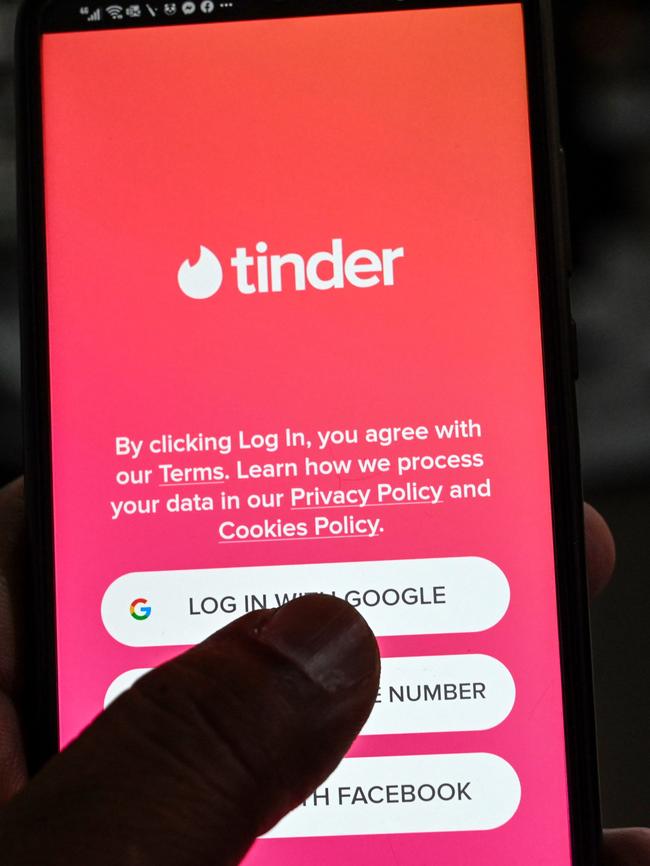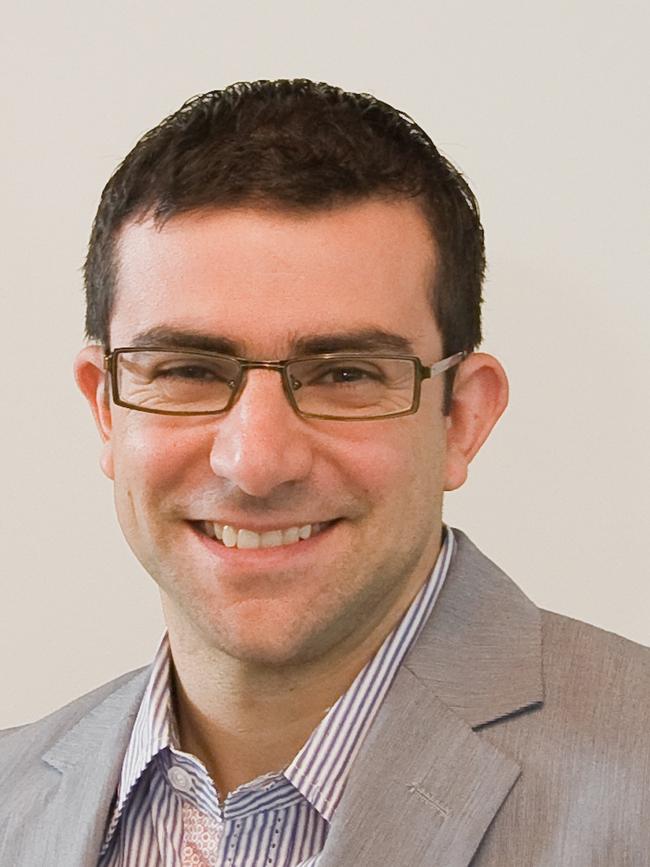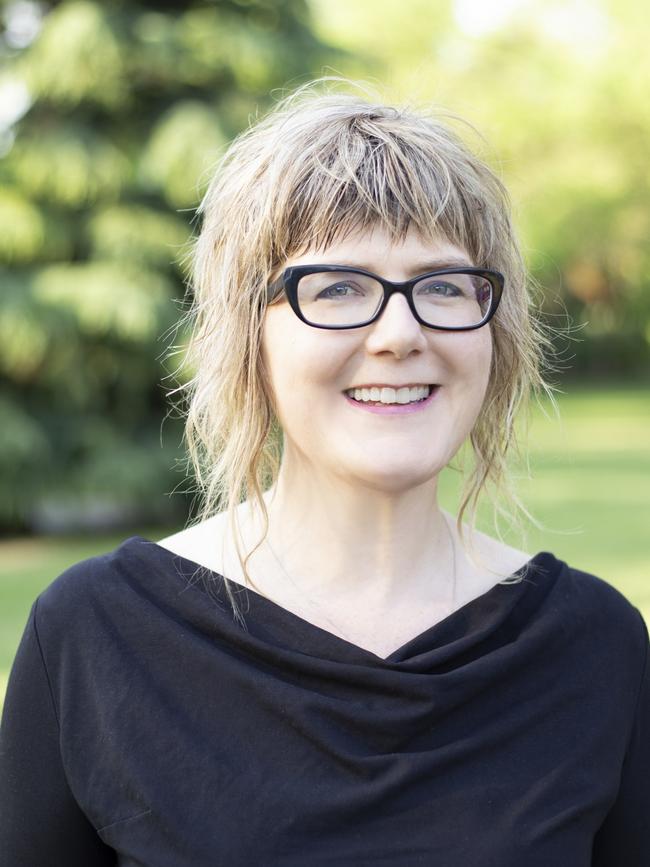How a decade of Tinder, and now Bumble and Grindr has changed dating for better or worse
From marriages and millions in revenue to catfishing and crimes, Tinder’s 10 years in the market hasn’t been dull. But what now for the original online dating app?
Business
Don't miss out on the headlines from Business. Followed categories will be added to My News.
Eugenia Lewis and Lara-lea Hadfield’s dating app experiences are so wildly different it’s almost hard to believe.
Ms Lewis, 30, met the love of her life on Tinder.
In February she married Rob Whiskin, 33, after a three-year relationship which involved early dates in London and Paris. Today she’s 29 weeks pregnant.
“I feel like once we met, everything just fell into place. Nothing has been super difficult, everything has just happened,” she said.
“He described me as just fitting the puzzle,” she said.

Ms Hadfield, 29, on the other hand, met a man who after a home cooked meal on a third date revealed a sexual fantasy involving a black apparatus and specific request.
“In his lounge he had this compartment that opened up like a glovebox. He pulled out this black apparatus,” she said.
“I was freaking out thinking he fully set me up. I said no and made up an excuse to leave. After that he was obsessed with me and would not leave me alone.”


Tuesday marks a decade since Australians first began swiping yes or no to date strangers on the internet without ever having met.
Online dating revolution
Tinder wasn’t the first online dating service to launch, but it was the catalyst for the normalisation of mobile app-based dating.
Today the act of browsing through potential partners like a clothing item in a catalogue – swiping through profile after profile, judging each suitor based on a small amount of information including a picture, their first name, age and height – is the mainstream, experts say and Tinder claims.
It’s a service some 3.2 million Australians actively used in 2020, according to Statista. About 25 per cent of Australians browsing apps – which include Grindr, Bumble and Hinge – to find love, friendship and all that falls in between, are between the ages of 25 to 34.
Tinder once famously claimed to have had 15 per cent of Australian population on the app in 2017 – a figure which would have represented 4.18m people.
Today it reports 530 million global downloads and 75 billion matches.
Statista’s data paints a different picture, with 57 million global users and 5.9 million paid subscribers as at the end of Q4 2019.
Australian revenue was its fourth most lucrative market, attributing $5.31m over that quarter from nearly 5900 users who paid to have their profile put before those they liked even if they hadn’t matched.


Despite its self-professed fame, Tinder wouldn’t participate in an interview, only providing brief and vague answers over email.
About 50 per cent of the company’s users are aged between 18 and 25, a spokeswoman wrote.
“There’s no denying that most people meet online these days and Tinder has played a key role in this over the past decade,” she said.
For better or worse?
While dating apps have long billed themselves as a way to socialise and democratise the world of relationships, many researchers strongly suggest otherwise, referencing their role in mental health decline, and in some cases even assault.
Lisa Portolan, 40, is the author of Love, Intimacy and Online Dating, a book related to her PHD research into online dating during the pandemic for Western Sydney University.
After speaking with 150 dating app users, she learned there were major impacts upon self-esteem.
“People are open about the fact that they became more judgmental on dating apps. People will now say, ‘OK, he’s not tall, dark and handsome, he’s gone’. The sort of things which they wouldn’t have been done in real life situations,” she said.
“The men were the people who were most affected and took an ego hit from using the dating apps. They are virtually very well outnumbered so statistically women will get more matches. Women tended to get more of an ego boost from using the apps because they did get more matches.”
Competitive industry
In 2014, former Tinder marketer Whitney Wolfe Herd introduced Bumble, a competitor to Tinder which sought to empower women by restricting men from making the first move.
Women were “still kind of sitting on their hands when it came to waiting for a man to ask them out”, said the company’s Australian spokeswoman Lucille McCart.
“She thought it was crazy that we’ve innovated in so many other areas of our lives and we’ve come so far but dating was still very traditional.”

Ms McCart would not disclose Bumble user stats, only that “a lot of our users are people in their 20s and 30s and interestingly, nearly 60 per cent of the people on Bumble in Australia indicate on their profile that they are looking for a relationship”.
A year later another competitor, Hinge, which claims to be the fastest growing dating app in Australia, the US, the UK and Canada, arrived.
A spokesman said the company had grown 56 per cent locally in January compared to the same time in 2020. Matches are also up 77 per cent over the same period and the app supposedly forms dates every two seconds globally.
The company would only share that 75 per cent of its global users were aged between 21 to 36.

Deakin University associate professor of relationship science Gery Karantzas is sceptical of the figures put out from dating app companies.
“We have very little hard evidence from the apps themselves as to what is considered a match,” he said.
“There is a free side to many of these apps but there is also a financial element to it as well so you do have to wonder why haven’t these stats been put out there.”
Mr Karantzas also believes dating apps have complicated modern romance.
One of the issues, he said, its that people now “suffer the paradox of choice”.
“If you give people many, many options, on face value it should be that the world is your oyster, the problem is that when you provide people with so much information, it is very difficult to make good decisions,” he said.
“You become so taxed mentally that you either make bad decision or you don’t make decisions at all.”
Modern dating
Kath Albury of Swinburne University of Technology likened Tinder to being the Facebook of online dating; everyone knows what it is and that it holds market share, but many, especially younger Australians, have chosen to go elsewhere.
“It has the most familiar interface because it kind of introduced the notion of the swipe so it’s used as the kind of generic representative of all dating apps,” she said.
“It’s been around for a while, people have a lot of complaints about it and it has the greatest critical mass in terms of users.”
Ms Albury found that heterosexual men and women spoke about dating apps differently. While women were more likely to see advice from friends, men didn’t share tips or advice, but sometimes sought the advice of gay friends or other women they knew, she said.
“Heterosexual men didn’t feel super confident about their ability to take a photo that would be attractive to a woman. They didn’t always know how to present themselves on the app and we know Tinder in particular really relies on your photos and making yourself look attractive,” she said.
“They want help but their teacher in sex and relationships education never taught them how to make a good profile on the apps or how to successfully slide into someone’s DMs (direct messages) on Instagram.”
Ms Albury found that many of the people she spoke to used other social media platforms to court potential partners.
“There are various platforms that people use for dating and certainly plenty of people said that they use platforms like Instagram, as a dating platform,” she said.


Despite finding little success among those she interviewed, Ms Portolan believes dating apps are part and parcel of modern dating.
“We forget that they’ve literally taken over dating and intimacy; they are the essential conduit to relationships,” she said.
“They have major social and cultural implications. People don’t walk up to someone anymore, they utterly rely on their phone. Even in a bar, they’ll still be on Hinge or Bumble.”
Ms Albury said while many people on dating apps didn’t take rejection lightly, in-person rejection was never any better.
“I often see all the woes of contemporary sexuality blamed on dating apps. I am 55 so I am old enough to have dated extensively pre-app. Of course people were horribly abusive in the bars and clubs particularly if you said no to their face,” she said.
“There were conflicts before dating apps and there are conflicts specific to dating apps.”
Ms Albury believes that modern dating is considered almost game-like for many, and it's a trend that formed well before Tinder arrived.
“There were plenty of people selling self-help books pre-dating apps about the rules for dating and how to get a husband. The pick-up artist book called The Game by Neil Strauss was published before dating apps and it was about how to guarantee that you could have sex with a woman,” she said.
“There was always a sense in which dating was gamified and people would try and sell you their top three tips for seduction.”
“I think dating apps have created among some people a generalised sense that dating should be easier and more transparent than it is because somehow the machine is going to do the work for you. Obviously it can’t, you’re still dealing with humans.”
Originally published as How a decade of Tinder, and now Bumble and Grindr has changed dating for better or worse





